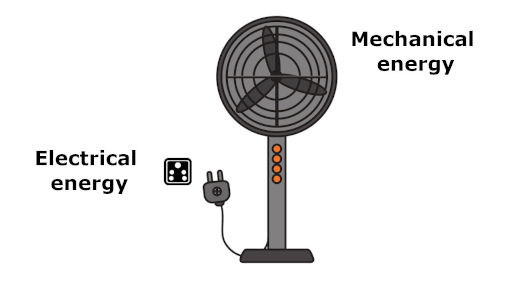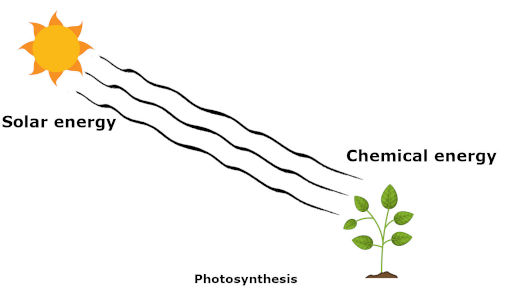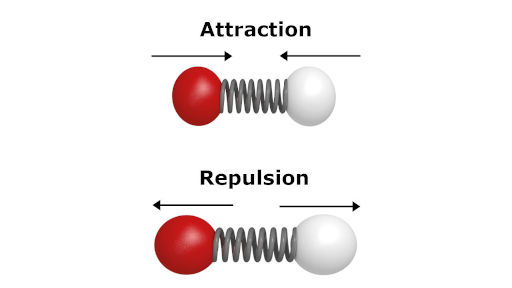
What did you notice in the above image?
One energy is converted into another. Right?
If you have understood at least few things in this image, you are done with the statement/definition of first law of thermodynamics.
Here is a statement of first law of thermodynamics;
“Energy can neither be created nor can be destroyed but the transformation of one form into another form can be possible.”
This statement/definition of first law wants to say that we cannot create any energy. Even we cannot destroy any energy. The energy can just be transformed from one form to another.
That’s it!!
Don’t worry I will also give you a simple real life example that will give you a proper idea of this statement.
Well, there are various energies which you already know.
Let us see few of these energies.
Contents
Various types of Energies
1) Mechanical energy

2) Heat energy

3) Electrical energy

4) Chemical energy

5) Kinetic energy

6) Potential energy

So these are some energies. Now let’s see how these energies are converted from one form to another.
How energy is converted?
Well, let’s take few examples now.
1) Heat energy into mechanical energy

A burning fuel possesses heat energy. You can see in the above animation that there is a burning fuel inside the cylinder.
Because of this heat energy, the pressure inside the cylinder rises and it lifts the piston.
This is nothing but a conversion of heat energy into mechanical energy.
2) Electrical energy into mechanical energy

A fan uses electrical energy and converts this electrical energy into mechanical energy.
3) Solar energy into chemical energy

You might be knowing this.
The solar rays have UV radiations. The plants absorbs these solar rays and converts them into chemical energy (as their food)
Thus you can see here the conversion of heat energy of a sun into chemical energy of plants.
There are many more examples based on the first law of thermodynamics that you can find from this detailed article on “examples of first law of thermodynamics.”
Well, from all these above equations, you can clearly see that the energies are converted from one form to another.
This is what the definition of first law of thermodynamics wants to say.
We saw from the above examples that the energy remains conserved.
Hence, the first law of thermodynamics is also known as the law of conservation of energy.
Statement of first law of thermodynamics based on mathematical equation (∆E = Q – W)
Now I’ll give you the definition of first law of thermodynamics in terms of heat, internal energy and work.

First law of thermodynamics:
The net change in total energy of a system (∆E) is equal to the heat added to the system (Q) minus work done by the system (W).
Explanation:
Whenever the heat is added or removed from the system, the heat total energy of the system changes.
Also if the work is done on the system or by the system, then also the total energy of the system gets changed.
This change in total energy of the system is given by the first law of thermodynamics as the difference in heat and work (i.e Q – W)
Thus the change in total energy of the system is given by;
E2 – E1 = Q – W
So, ∆E = Q – W
Now, you might be wondering what is this total energy (E)?
Well, total energy is nothing but the sum of kinetic energy and potential energy of the molecules of substance.
I’ll explain this, don’t worry.
See, all the substances are made up of atoms and molecules. These molecules have various types of motions

And you know very well that if some object is in motion, then it possesses kinetic energy. Now as this motion is related to the molecules, it is known as molecular kinetic energy.

Same way, attractive and repulsive forces are also present among the molecules of the substance.
This attractive and repulsive forces indicate the potential energy (Molecular potential energy)
Now total energy is nothing but the sum of kinetic energy, potential energy and other energies present in the molecules of the substance. This sum of energies is also known as internal energy (U)

Majorly, the molecules possess kinetic energy and potential energy only.
So we can define internal energy as a sum of molecular kinetic energy and molecules potential energy.
You know why it is named “internal” energy?
Because it is the energy that is possessed by the internal molecules only. That’s the reason why it is named internal energy.
Summary
Statement of first law of thermodynamics as a law of conservation of energy.
“Energy can neither be created nor can be destroyed but the transformation of one form into another form can be possible.“
Statement of first law of thermodynamics in terms of heat, internal energy and work.
“The net change in total energy of a system (∆E) is equal to the heat added to the system (Q) minus work done by the system (W).“
∆E = Q – W
I hope you have clearly understood both the Statement/definition of First Law of Thermodynamics. If you have any queries, feel free to comment below.
Important Guides for you
Also read:
- What is thermodynamics? (35+ topics with definitions and examples)
- Zeroth law of thermodynamics
- More topics on First law of thermodynamics
- Examples of First Law of Thermodynamics / Law of conservation of Energy
- First law of thermodynamics equation (A practical explanation)
- Limitations of First Law of Thermodynamics
- What is second law of thermodynamics? [8+ Best examples to remember the law]
- Examples of Second Law of Thermodynamics (8+ best examples)
- Second Law of Thermodynamics Definition/Statement (Next level explanation)
- Second Law of Thermodynamics Equation [Practical explanation]
- What is third law of thermodynamics? (in simple terms)
- Laws of thermodynamics
- What is Carnot Cycle in Thermodynamics?
- What is the definition of entropy in thermodynamics?
- Heat capacity vs specific heat in thermodynamics
- What is Thermodynamic Equilibrium? (With Best Example)
- Thermodynamic Process (With Examples)
- What is Thermodynamic System? – Open, Closed & Isolated system (With Examples)
